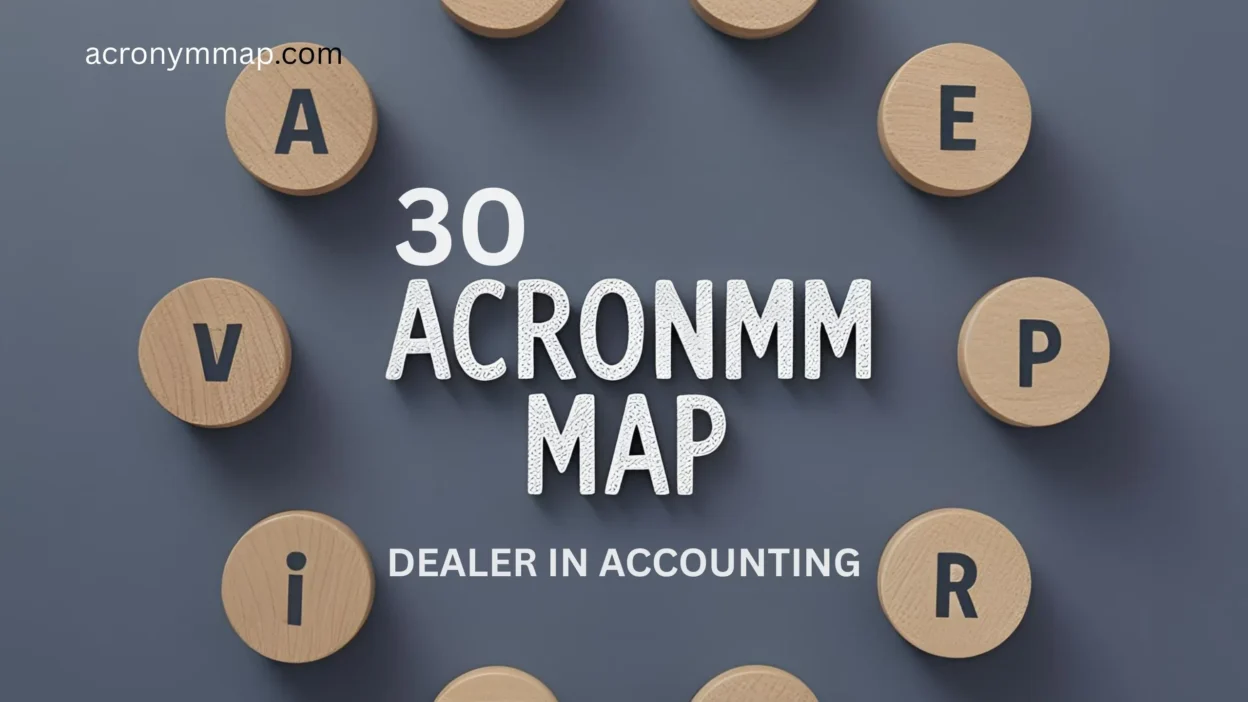In accounting, acronyms aren’t just shortcuts—they’re tools for clarity. One of the most widely taught is the DEALER acronym. It helps students and professionals understand debit and credit rules by categorizing accounts into two main groups:
🧮 What is the DEALER Acronym?
DEALER stands for:
- D – Dividends
- E – Expenses
- A – Assets
(These three accounts increase with a debit.) - L – Liabilities
- E – Equity
- R – Revenue
(These three accounts increase with a credit.)
This framework helps you understand which side of a transaction increases an account—a foundational concept in double-entry accounting.
🔄 30 Alternatives to the DEALER Acronym in Accounting
While DEALER is popular in education, professionals may use variations or other mnemonic devices to understand account types, debits and credits, or financial structures. Here are 30 related acronyms, terms, or groupings—with usage tips and examples.
1. DEAD CLIC
Meaning: Another dual-sided accounting mnemonic.
Breakdown:
- DEAD – Debit: Expenses, Assets, Drawings
- CLIC – Credit: Liabilities, Income, Capital
Example: DEAD CLIC helps beginners grasp double-entry rules.
Use when: Teaching debit/credit basics.
2. REAL
Meaning: Revenue, Expenses, Assets, Liabilities
Example: REAL accounts show the ongoing financial health of a business.
Use when: Describing balance sheet components.
3. PERMANENT Accounts
Includes: Assets, Liabilities, Equity
Example: Permanent accounts carry balances forward to the next fiscal year.
Use when: Explaining balance sheet dynamics.
4. TEMPORARY Accounts
Includes: Revenue, Expenses, Drawings
Example: Temporary accounts are closed at the end of each period.
Use when: Discussing the income statement or closing process.
5. ALOE
Meaning: Assets = Liabilities + Owner’s Equity
Example: ALOE is a helpful way to remember the accounting equation.
Use when: Teaching fundamental accounting structure.
6. CHER
Meaning: Capital, Liabilities, Expenses, Revenue
Use when: Explaining account behavior.
Example: CHER shows how different accounts affect financials.
7. ICORE
Meaning: Income, Capital, Owners’ Equity, Revenue, Expenses
Use when: Organizing core financial categories.
8. GLADE
Meaning: Gains, Losses, Assets, Drawings, Expenses
Use when: Teaching accounts affected by debits.
Example: GLADE accounts all increase with a debit.
9. LICOR
Meaning: Liabilities, Income, Capital, Owners’ Equity, Revenue
Use when: Discussing credit-increasing accounts.
10. COIL
Meaning: Credit: Owners’ Equity, Income, Liabilities
Use when: Simplifying credit accounts.
11. DIRE
Meaning: Debit: Increase Revenue & Expenses
Use when: Explaining exceptions in journal entries.
12. AELR
Meaning: Assets, Expenses (Debits) | Liabilities, Revenues (Credits)
Example: Use AELR to group accounts based on balance type.
Use when: Summarizing financial statements.
13. ARCL
Meaning: Assets, Revenue, Capital, Liabilities
Use when: Discussing major financial account types.
14. CARLE
Meaning: Capital, Assets, Revenue, Liabilities, Expenses
Example: CARLE is helpful for balance sheet breakdowns.
Use when: Covering both financial statements.
15. ICED
Meaning: Increase Credit: Income, Capital
Use when: Explaining credit-increasing logic.
Example: ICED accounts rise with credit entries.
16. DR CLIC
Meaning: Debit: Revenue, Capital | Credit: Liabilities, Income
Use when: Mnemonic for entry balancing.
17. CLEAR
Meaning: Capital, Liabilities, Expenses, Assets, Revenue
Use when: Grouping accounts for teaching.
18. DIALER (variant of DEALER)
Adds: I for Income
Use when: Need to separate Income from Revenue in nuanced systems.
19. RALE
Meaning: Revenue, Assets, Liabilities, Equity
Use when: Teaching high-level account categories.
20. ROCE
Meaning: Return on Capital Employed
Use when: Transitioning from basic accounting to financial analysis.
Example: ROCE helps measure efficiency of capital use.
21. EBITDA
Meaning: Earnings Before Interest, Taxes, Depreciation, and Amortization
Use when: Talking about financial performance.
Example: EBITDA offers a clear picture of operating profitability.
22. FIFO / LIFO
Meaning: Inventory valuation methods (First In First Out / Last In First Out)
Use when: Describing inventory and COGS accounting.
Example: LIFO lowers profit in times of inflation.
23. GAAP
Meaning: Generally Accepted Accounting Principles
Use when: Discussing standardized reporting.
Example: GAAP ensures financial consistency.
24. IAS / IFRS
Meaning: International Accounting Standards / International Financial Reporting Standards
Use when: Global financial reporting.
Example: IFRS compliance is key for global investors.
25. T-Account
Visual tool: For mapping debit/credit sides
Use when: Teaching journal entries.
Example: T-Accounts simplify learning the double-entry method.
26. AR / AP
Meaning: Accounts Receivable / Accounts Payable
Use when: Explaining current assets and liabilities.
Example: AR reflects incoming money, AP outgoing obligations.
27. COGS
Meaning: Cost of Goods Sold
Use when: Calculating gross profit.
Example: COGS is subtracted from revenue in income statements.
28. RE
Meaning: Retained Earnings
Use when: Tracking profit reinvestment.
Example: RE grows over time if profits are reinvested.
29. DR / CR
Meaning: Debit / Credit
Use when: Entry-level bookkeeping shorthand.
30. BS / IS
Meaning: Balance Sheet / Income Statement
Use when: High-level summary in reports.
Example: BS shows assets; IS shows performance.
🧭 Choosing the Right Acronym
When selecting a mnemonic or acronym in accounting, keep in mind:
- Audience: DEALER and DEAD CLIC are great for beginners, while acronyms like EBITDA and GAAP are better for advanced learners.
- Context: Use T-Accounts and FIFO/LIFO when dealing with specific transactions or inventory.
- Purpose: Choose based on whether you’re explaining account types, journal entries, or performance metrics.
✍️ Final Thoughts
The DEALER acronym is a foundational tool for grasping accounting basics—but as your understanding grows, you’ll need a larger set of terms and mnemonics to navigate the full financial landscape. Whether you’re a student, educator, or small business owner, learning when and how to apply each acronym will sharpen your accounting fluency.
Keep this list handy and revisit it as your financial journey evolves. The right term at the right time makes all the difference in understanding—and explaining—accounting.

